The Italian arms importation scheme, 1920-1921
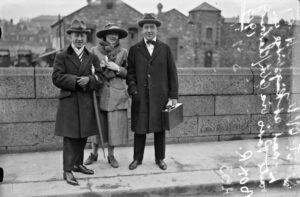
How the clandestine Irish Republic attempted to buy arms from Italian ultra-nationalist leader Gabriele D’Annunzio. By Jack Traynor
As the guerrilla campaign against British forces intensified in 1920 the hard-pressed IRA in southern flashpoints like Cork and Tipperary applied pressure on General Headquarters to devise a new military strategy to escalate the war and to make greater efforts to acquire arms for the beleaguered Republican forces.
Their piecemeal acquisition of captured British arms was fast becoming unviable in the increasingly violent conflict. Urgent materiel needs of the IRA coincided with the hatching of a plan to import a large quantity of arms from Italy for the prosecution of the Republican war effort.
Envoys of the Irish Republic came into contact with the Fiume regime headed by the Italian ultranationalist Gabriele D’Annunzio and planned a major gun running operation to Ireland.
In Europe, roving envoys of the Irish Republic came into contact with Italian representatives of the Fiume regime headed by the eccentric Italian general and ultranationalist Gabriele D’Annunzio whose occupation of the Adriatic city began in September 1919.
Utilising such contacts for practical gains, from autumn 1920 onwards advanced plans were devised by Irish Republicans and Italian sympathisers for the orchestration of a major gun-running operation. Republicans privy to the secret plans, such as Florence O’Donoghue, believed the potential arms windfall could be a game changer in the ‘Tan War’: he described the plans as ‘the most important effort to obtain a substantial quantity of arms undertaken since 1916’.[1]
Despite elaborate plans concerning the importation and meting out of the arms throughout the country and the high hopes of various Republican militarists for its strategic significance, the operation was furtively aborted by GHQ in 1921.
The cloak and dagger surrounding its cancellation led some of those involved on the peripheries to retrospectively query its seemingly inexplicable abandonment and begin to suspect elements of subterfuge. O’Donoghue recalled it was not until after the Truce of 11 July 1921 when he learned of the ‘complete failure of the project’ but acknowledged he had no knowledge of ‘why the project failed in Italy’. [2]
For Republican militarists, the Italian operation seemed to signify the long-awaited ripening of tangible fruits of the Republic’s foreign policy, which had hitherto often produced mere propaganda spectacles during de Valera’s barnstorming tour of the United States whilst producing disappointment in the Paris Peace Conference.
The Italian plans were described in the memoirs of Liam Deasy and Ernie O’Malley, whilst Bureau of Military History witness statements help to illuminate the story of the elusive Italian arms and their failure to materialise on Irish shores. This article utilises such material to sketch the origin, development, and abandonment of the ambitious scheme.
Continental background: The Paris Peace Conference
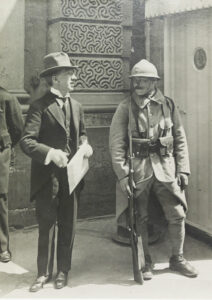
From January 1919, the revolutionary Irish Republic sought to associate the cause of Irish independence with the principle of self-determination, which became the zeitgeist of the immediate post-war era as championed by US president Woodrow Wilson.
Despite the refusal of the victorious Allied powers to afford Irish Republicans a hearing at the Paris Peace Conference, de Valera promoted Irish independence as a fulfilment of American war pledges to secure freedom for small nations.
In June 1919, Irish Republican foreign policy was reoriented towards influencing opinion in the United States, culminating in the mission to America. Accordingly, the raison d’être of the Republic’s European diplomatic outpost in Paris shifted. Seán T. O’Kelly, the Republic’s accredited diplomat to Paris, admitted feeling ‘awfully tired of this place… there is so little to do here these days that it seems a shame to be cooped up in such an oven’.[3]
Both Irish and Italian nationalists were, in different ways, disappointed by the outcomes of the Paris Peace Conference
Following a lacklustre unofficial meeting with the American president, O’Kelly informed Dublin that ‘we have little or nothing to hope from Wilson’s efforts on our behalf’.[4]
O’Kelly spearheaded a foreign policy refocus towards achieving different goals such as forging a relationship with the Vatican and spreading pro-Irish propaganda. The latter was regarded as particularly important to combat what Count Plunkett called the ‘strong British Propaganda campaign against Ireland in the press of foreign countries’.
Plunkett further reported to the Dáil in October 1919 that ‘Messrs. O’Kelly and Duffy in Paris, Madam Vivanti in Switzerland and Italy and Mr. D. M. Hales in the latter country, have been working hard to counter-act this [anti-Irish Republican propaganda], and continue to meet with a fair measure of success.’[5] Another important task for Republican envoys abroad was to source arms for the war effort. O’Kelly was tasked by Michael Collins with helping in the purchase of arms in France, yet he admitted that ‘we tried every trick; we searched every nook and cranny; we failed’.[6]
By the end of 1919, Italian and Irish disenchantment with the Paris Peace Conference was firmly entrenched.
Italy, as an Allied power, felt aggrieved at having been denied the territorial annexations promised by Britain and France in the secret Treaty of London of 1915 when it came to redrawing the map of post-war Europe. Though they did gain territory, notably the cities of Trieste and Trento, the territorial future of the city of Fiume, previously Austro-Hungarian, became the ground-zero for a rupture between Italy and the Allied Powers. Wilson refused to concede the city despite its assumed Italian majority (although no reliable demographic figures were available in 1919).[7]
Wilson rationalised that Fiume was crucial to the economic survivability of the new Kingdom of Serbs, Croats, and Slovenes (soon to be renamed Yugoslavia) – a crude invocation of the dismal science which appeared to contradict his self-determination policy, which outraged Italian nationalists.[8]
D’Annunzio’s coup in Fiume
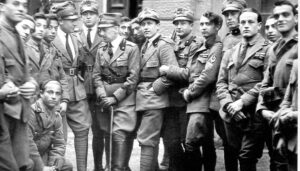
The Fiume crisis was exacerbated by the Italian general and poet Gabriele D’Annunzio who led an army of 2,600 nationalist war veterans to capture the city in an irredentist coup d’état on 12 September 1919. He opposed Italy’s ‘mutilated victory’ in the war -claiming that Italy had not been sufficiently rewarded for its sacrifices with the award of new territory, especially that populated by ethnic Italians.
In defiance of the new international order, he declared Fiume an independent state, the ‘Italian Regency of Carnaro’ under his dictatorial rule as Comandante.
D’Annunzio, in defiance of the new international order, seized Fiume in an armed coup and declared it an independent state, the ‘Italian Regency of Carnaro’ under his dictatorial rule as Comandante.
The rapidly developing events in Italy and the continued activities of Irish Republican envoys on the continent set the stage for the opening of backchannels with representatives of D’Annunzio’s Fiume. In late October 1919, D’Annunzio publicly signalled his support for Irish independence in a speech which was translated and published by the playwright and Fiume-collaborator Henry Furst as the pamphlet Italy and Life.
In it, D’Annunzio elucidated the world-historical significance of his expedition, acknowledging that even if they were to fail in Fiume, their actions would inspire national liberation movements the world over, including revolts against British rule in Ireland and Egypt:
‘From the ruins [of Fiume] the spirit will leap forth watchful and active. From the dauntless Sinn Fein of Ireland to the Red banner which in Egypt unites the Crescent and the Cross, all the insurrections of the spirit against the devourers of raw flesh and against the exploitations of weaponless peoples, will catch flame anew from our sparks which fly afar’.[9]
Not all observers in Ireland were impressed. The traditionally pro-Home Rule Irish Independent disparagingly denominated the coup as the ‘Comedy of Fiume’[10] and the ‘Farce of Fiume’, referring to the continually unfolding events as ‘more stage-thunder’.[11]
However the Irish press also reported on a sudden arms windfall in Fiume. The Persia, a ship laden with weapons bound for the White Army in Russia, was captured by the Fiume collaborator Giuseppe Giulietti of the Italian Maritime Workers Union on 10 October 1919. The Irish Independent reported that the ship was ‘brought to Fiume… with arms and food’. The article quoted D’Annunzio: ‘We want to light a fire that will burn high. It will awake in a portentous flame the deceived hopes of the oppressed peoples.’[12]
O’Kelly recognised Fiume was ‘so plentiful [with] guns and ammunition’. He sought to acquire arms from the well-stocked Fiume arsenal through clandestine contact with D’Annunzio, a Sinn Féin sympathiser.[13]
Forging Italian contacts
O’Kelly’s eagerness to establish contact with the Italian occupants of Fiume mirrored D’Annunzio’s own aspirations to forge a relationship with the Irish Republicans. D’Annunzio’s motivations were partly ideological: he believed Italy was a ‘proletarian nation’ (a neologism he borrowed from fellow poet Giovanni Pascoli) which lay outside the clique of bourgeois-liberal powers who had entrenched their post-war domination through the peace treaties devised at Paris and through the League of Nations.
D’Annunzio saw in the Irish Republic declared in 1919, a natural ally for his initiative in Fiume. He may also have wanted to court Irish American opinion.
Accordingly, he sought to gather the ‘oppressed’ nations together in a new supranational venture, the League of Fiume, which would serve as an ‘anti-League of Nations’. León Kochnitzky, a Belgian poet and the de facto Minister for Foreign Affairs of Fiume, wrote to the Comandante on 27 March 1920 to express his belief that the proposed League of Fiume would receive the ‘certain support’ of ‘Fiumans, Dalmatians, representatives of the islands [of the Adriatic], Egyptians, Indians, Irish.’[14]
Defending the international element of the (failed) Fiume project, Kochnitzky wrote that Fiume was ‘a Western and Latin city on the border of the Slavic and Muslim East, it owed its free life to a rebellious act; naturally the oppressed raised their eyes towards Carnaro’.[15]
However, D’Annunzio’s decision to seek a relationship with the Irish Republic was also motivated by realpolitik. His Fiume expedition failed to ignite the flame of ultranationalism in Italy.
Instead, the November 1919 elections returned the liberal F.S. Nitti – who was against further annexations of territory by force – to the premiership and drastically increased Socialist representation in parliament. Nitti despatched General Badoglio to negotiate a settlement with D’Annunzio, which resulted in the proposed modus vivendi by which Italy would occupy the city but guarantee League of Nations control of the port and railroad lines.
Complicated political wrangling in Fiume arose from the modus vivendi, which was overwhelmingly endorsed by the public in a plebiscite on 18 December yet was overturned by D’Annunzio. Precociously perceiving the deterioration of his domestic position, D’Annunzio accelerated efforts to forge international contacts and alliances. Fiume’s representative in Paris, Giovanni Giurati, reported to D’Annunzio in a 19 January 1920 letter that he successfully gained interviews with O’Kelly and with the Egyptian nationalist Wafd Party.
During these interviews, Giuriati floated the idea with both nationalities of a formalised alliance with Fiume for the purposes of disseminating anti-Allied propaganda internationally.[16]
By seeking an alliance with Irish Republicans, D’Annunzio may also have hoped to gain the support of Irish-Americans whose influence could then be utilised to pressure President Wilson to adopt a less hostile stance towards Fiume.
In the United States, the Italian-American community by-and-large supported his Fiume adventure. Carlo Barsotti of Il Progresso Italo-Americano organised a fund to aid D’Annunzio and claimed that the only impediment to solving the Fiume Question was the ‘domineering attitude’ of President Wilson whilst New York Democrat Al Smith recognised the extent of Italian-American sympathy for D’Annunzio as they expected Tammany Hall, dominated by Irish-Americans, to push for a favourable solution to the Fiume crisis.[17]
The prospect of uniting the two largest Catholic ethnic groups in the United States in support of Fiume would have considerably strengthened D’Annunzio’s domestic and international position.
O’Kelly’s Mission to Rome
In January 1920 Seán T. O’Kelly relocated to the Irish College in Rome to recover from rheumatic fever. At the Irish College he renewed his friendship with the college’s rector, Monsignor John Hagan, who was ‘the main architect of [the Republic’s] Vatican policy, acting at the same time as a mediator between bishops, politicians and the Holy See.’[18]
In January 1920, Seán T. O’Kelly, the Irish Republic’s envoy to the Paris Peace Conference, relocated to the Irish College in Rome, where he soon came into contact with D’Annunzio’s supporters.
Throughout early 1920, O’Kelly busily endeavoured to improve the Republic’s relations with the Vatican, often composing cloyingly sycophantic letters to the Pope.[19] He credited an audience with Benedict XV on 12 April as decisive in staving off an outright condemnation of the IRA by the Vatican,[20] as Cardinal Merry del Val pressured the Pope to denounce their ‘terroristic methods’.[21]
It is unclear whether contact was first initiated by the Irish or D’Annunzio. The witness statement of Monsignor Curran suggests that a relationship was actively sought by D’Annunzio. In the midst of O’Kelly’s Vatican mission, he received an unexpected epistle from Fiume in April 1920, which he acknowledged was composed by Henry Furst.[22] It heralded the foundation of the League of Fiume to rally ‘the forces in open or occult opposition to the tyranny of Versailles and the pseudo-League of Nations’.[23]
D’Annunzio’s delegation
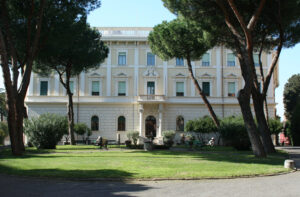
Later that month, D’Annunzio sanctioned a mission of representatives to meet O’Kelly at the Irish College. Unable to personally receive the delegation, the task of greeting these peculiar guests – ostentatiously dressed in military-style uniforms – fell to the vice-rector Monsignor Curran.
The delegation presented Curran with a declaration ‘against the British Empire, particularly for its oppression of Ireland, and joining in the declaration of the Irish Republic’. They informed Curran of their fantastical intention of organising an expeditionary force from Fiume which would fight alongside the IRA.
Talks were held by the Irish with D’Annunzio’s delegation via Monsignor M.J. Curran, the rector of the Irish College. Some of the Italian proposed leading a military expedition to Ireland
The Irish clergyman dissuaded his guests from a military excursion. Informed that differences of language and their obvious foreignness would render their participation in an Irish guerrilla war impractical, as such a war requires rebels to pass undetected from place to place, the delegation eventually backed down.
He spared their feelings by declining to bluntly tell the Italians that as ecclesiastics the Irish College had no business ‘organis[ing] a revolutionary invasion, even to help the duly elected government in Ireland’.[24]
Nonetheless, the delegates clung to the resolution agreed by their National Council ‘against the League of Nations and the oppression of the British Empire’.[25] The League of Fiume also took it upon itself to issue a public remonstration to Eric Drummond, Secretary-General of the League of Nations, condemning British imperialism in Ireland and elsewhere:
‘[T]he British Empire has, by inflicting upon Ireland, upon Egypt and upon India the most cruel and wicked yoke, shown itself to be, more than any other state whatsoever accused of militarist misdemeanours, unworthy of the respect and of the confidence of civilized peoples.’[26]
Between late May and early June 1920, O’Kelly received a letter from D’Annunzio which formally invited the Irish Republic to join the League of Fiume. He incentivised the Irish to commit to membership by holding out the promise of arming the hard-pressed IRA with munitions from Fiume’s arsenal.
O’Kelly doubted that D’Annunzio ‘can be of any political use to us’, but looked into ‘getting munitions cheap’ from Fiume.
O’Kelly reported the offer to Arthur Griffith in Dublin on 18 June, informing him that he had not yet replied but he intended to ‘simply send a non-committal answer’. He doubted that alignment with D’Annunzio ‘can be of any [political] use to us.’ He informed Griffith and Michael Collins that he would be ‘making enquiries into the possibilities of getting munitions cheap from Fiume’, just as the Egyptian nationalists had. O’Kelly acknowledged that D’Annunzio was ‘not inclined to be very philanthropic in this matter’, which indicated his belief that the offer had strings attached.[27]
O’Kelly seemed to suggest the opening of dialogue between the Irish and representatives of Fiume was initiated by the Irish themselves for the purpose of acquiring arms from D’Annunzio through ‘mutual friends’ like Annie Vivanti.[28]
Vivanti was an Italian writer married to John Chartres, whom Dermot Keogh described as ‘a shadowy figure who was one of the Sinn Féin envoys’.[29] Nancy Wyse-Power described Vivanti as ‘a person of influence, a friend of [D]’Annunzio and Mussolini’.[30] O’Kelly sent her to meet ‘her friend’ D’Annunzio. Upon her return from Fiume, she reported that D’Annunzio was strongly in favour of Irish independence.[31]
O’Kelly also met Benito Mussolini who, at that time not in power, but a rising political force, approved of the arms shipment to Ireland.
D’Annunzio also made arrangements for O’Kelly and Vivanti to meet Benito Mussolini.[32] They met the ‘friendly and sympathetic’ Mussolini on 20 August 1920 in Milan. The fortuitous meeting ended in ‘delight’ for the two Republicans as the future Duce vowed to honour their request for arms: ‘He drafted a letter to D’Annunzio immediately allowing him to give us a boatful of guns and ammunition for free; we had to acquire the boat and crew ourselves and to be responsible for landing it all in Ireland’.[33] This apparently successful meeting became the origin of the Italian gun-running plans.
Preparations for the importation of Italian arms
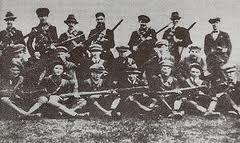
The promise made at the Milan meeting, which aroused such delight in O’Kelly, was quickly recognised as an opportunity to be seized. Plans were quickly devised in Ireland to facilitate the acquisition, transport, landing and dissimilation of the lucrative bounty.
Dónal Hales, a Republican envoy in Genoa, received orders from Dublin to make arrangements for the gun-running in Italy. Hales, of a well-known Republican family from West Cork, was undoubtedly aware of the precarious military situation at home through his brothers Seán, Tom and Robert.
As the War of Independence intensified, ‘throughout Ireland the IRA was almost entirely dependent upon captured arms, and GHQ was constantly being petitioned to try and import arms by some means.’[34]
The Italian arms scheme was approved by the Irish Republican civil and military leadership and Cork IRA officer Michael Leahy was sent to Italy to facilitate it.
One such petition effort came in late 1920, as the southern-based IRA agreed to pressure GHQ and the Republican leadership to act on ‘the need for more arms – particularly rifles’ and to devise a strategy for an escalation of the conflict.[35]
In late 1920, the possibility of acquiring thousands of Italian rifles appeared to the Republican leadership as manna from heaven which had come at the perfect time. Hales accompanied an Italian army officer to the War Ministry in Rome where they were promised ‘as many rifles as we wished – up to 100,000’. The rifles were used by Italian forces in the recent war and were ‘in good condition and only required cleaning.’[36] Evidently, rogue elements within the Italian military were willing to covertly support the Irish Republic.
Cork IRA intelligence officer Florence O’Donoghue recalled being notified that ‘GHQ had a project for the importation of arms.’ Collins had been involved in the Italian plans since August.[37]
Hales had also written to Art Ó Briain, an Irish agent in London, regarding the possibility of importing ‘furniture’ [firearms] from Italy.[38] O’Donoghue was summoned in December 1920 to a meeting at Barry’s Hotel in Gardiner’s Row in Dublin with GHQ officers to discuss the arms importation project in detail. [39]
Liam Deasy, Commander of the IRA First Southern Division, recalled that also in attendance were Collins, Cathal Brugha, Liam Mellows and Joe Vize.[40] O’Donoghue was asked to nominate an officer with seafaring experience to travel to Italy. It was decided that Michael Leahy of the Cork IRA No. 1 Brigade, would undertake this role and spearhead the effort.
Though O’Donoghue recognised they ‘could ill spare [Leahy] at the time, we regarded the project as the most important effort to obtain a substantial quantity of arms undertaken since 1916’.[41] It was agreed, wrote Ernie O’Malley, that ‘20,000 rifles, 200 rounds for each rifle and 600 machine-guns’ would be imported from Italy.[42] They agreed to smuggle the arms into the West Cork coast.[43]
The local Brigade Staff decided that Squince Strand in Rabbit Island, Skibbereen would be the ideal place to land the arms as firstly it was separated by distance from heavy concentrations of British forces in Cork, Kinsale and Bandon and secondly its ‘coast of sandy shores’ could safely allow the ship to be beached, ‘and so quickly and safely unloaded’.[44]
Suitable arms dumps were identified around Cork whilst the local IRA planned to distribute the arms to North Cork and Limerick for dissemination throughout the country. Plans were also made for armed protection patrols along the Cork coast to ensure the operation went smoothly and without interference.[45]
A ship, the Stella Maris was acquired. It was planned to land the arms surreptitiously at beaches in West Cork and from there to distribute them around the country.
In January 1921, Leahy travelled pseudonymously to the continent purporting to be a seminarian. In Genoa, Leahy met Hales who introduced him to ‘three of D’Annunzio’s officers in the Fiume coup’ who enthusiastically expressed their sympathy for the Irish cause. One eager Italian, a Captain Frugonie, even desired to accompany Leahy back to Ireland ‘in the arms ship and take a hand in the fight with us’.[46]
Seán O’Shea was also dispatched by Brugha, the Minister for Defence, to rendezvous with Hales in Italy. O’Shea recalled that he travelled with Hales to the War Ministry in early 1921 for a meeting with their Italian collaborators which confirmed ‘an order for the military equipment’ and considered complex preparations including the provision of ‘a false bottomed ship which was to transport the equipment’ and the purchase of ‘marble and architectural work in Genoa which was to act as a camouflage for the arms’.[47]
The conspirators acquired the Stella Maris, a ship owned by the Giulietti’s Maritime Workers Union, and devised plans for it to carry ‘rifles, machine guns, revolvers and proportionate ammunition’ to Ireland and then travel on to Newcastle (England) where it would stock up on coal and return to Italy.[48]
The plan unravels
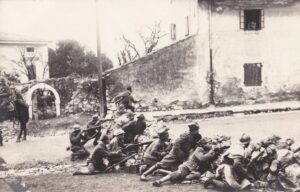
For D’Annunzio, 1921 began bleakly in the immediate aftermath of the ignominious end of his regime on 30 December following the ‘Bloody Christmas’ fighting between the Italian government and Fiume’s occupants.
D’Annunzio and his followers were ultimately forced to abandon Fiume, when he came under attack by Italian military forces, after the government had signed a Treaty with Yugoslavia whereby Fiume was to be a ‘free state’ for four years. The New York Times reported D’Annunzio’s future ‘destination is unknown, but Ireland and South America are mentioned’.[49]
An 11 March letter from George Gavan Duffy to Robert Brennan, the Republic’s Under-Secretary of Foreign Affairs, claimed ‘the poet wants a new field and thinks of Ireland, India and Egypt’.
The plan for the arms shipment began to go wrong when D’Annunzio was ousted from Fiume by Italian government forces in December 1920.
He acknowledged that D’Annunzio’s presence in Ireland ‘would offend some elements’ and that ‘he is a man of notoriously bad life’, however, he believed that ‘weighing the pros and cons, we would gain by his companionship and the Vatican would be likely to treat us with a little more respect, if with less affection’ due to his being ‘the biggest figure in Italy’. He proposed: ‘I think I should go to him with a written invitation [from Dáil Éireann]’.[50]
Such an extraordinarily significant diplomatic gesture would have reversed the ‘non-committal’ policy towards D’Annunzio and the League of Fiume. Gavan Duffy wrote to Hales in April 1921 that ‘It looks as if the Fascisti w[oul]d be a very strong power in the new Parliament and I fancy our friend [D’Annunzio] will be pretty close to them’.[51]
The foreign policy turnabout towards D’Annunzio may be understood as gratitude, though Gavan Duffy fails to recognise that D’Annunzio’s political career was at its nadir by then. De Valera emphatically rejected alignment with D’Annunzio for fear it would drive a wedge between the Irish Republic and important elements such as the Church, who regarded D’Annunzio as ‘a Nietzschean’ whose works were ‘at the service of pornography’,[52] whilst the Labour movement denounced ‘that buccaneer D’Annunzio… for resorting to force in Fiume’ at the August 1920 annual meeting of the Labour Party and Trade Union Congress.[53]
Abandonment of the operation
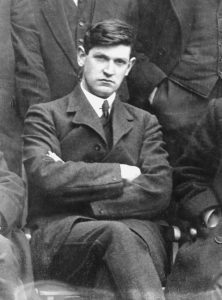
Despite meticulous preparations, the project was delayed and finally aborted surreptitiously by Collins. The seismic events of the Truce and the subsequent Treaty overshadowed the Italian plans, which were gradually shelved. Those involved in the plans recalled frustration and confusion. O’Shea remembered ‘a few months elapsed and there was no word of the military equipment from Italy arriving in Ireland’.[54]
Meanwhile, Leahy felt he was ‘becoming desperate… because of no direction of any kind coming from Ireland’.[55] Vol. Jack Plunkett recalled ‘the amazement of many people at the delay’ of the arrival of Italian munitions.[56]
Was Collins simply parsimonious? It seems unlikely that financial difficulties prevented the operation’s orchestration. A relatively meagre sum of £10,000 was requested for the munitions. Collins informed Hales this ‘would present no difficulty at all’. However, the payment was never made.[57]
Despite meticulous preparations, the project was delayed and finally aborted surreptitiously by Michael Collins.
The operation’s failure has been attributed to an intelligence leak. On 7 July, Collins informed Hales that ‘the business… has not been found practicable’ due to Britain’s catching wind of the plans.[58] It would not have required exhaustive espionage to discern that something was brewing between Ireland and Fiume. The Los Angeles Herald reported on 31 December 1920 that the former Comandante would ‘escape to Ireland where he would offer his sword to the achieving of Irish liberty’.[59]
O’Kelly blamed D’Annunzio for giving ‘a fiery speech’ to the press where he claimed to be ‘the first Italian Sinn Féiner’ and announced he was ‘about to direct an Italian detachment to Ireland to fight for freedom. And he wouldn’t go without ammunition and war supplies.’ In O’Kelly’s view D’Annunzio essentially sabotaged the Italian arms operation through his arrogant outbursts:
‘The next thing we heard was that, within four hours, there was a British warship watching over Fiume and that the loading of the arms had to be put off. We thought at first that it would just cause a delay, but our crew never left Genoa and we never got as much as a rifle from D’Annunzio.’[60]
In post-War of Independence Ireland, suspicion and rumours circulated about the operation’s failure. Hales believed ‘the arrangements to procure arms may have been to bluff England’ into coming to the negotiating table sooner if they believed the IRA were ‘fully armed [and] could hold out longer and kill most of the British soldiers here’.[61] Meanwhile, Monsignor Curran repeated the truism that ‘the shortage of arms… [caused] a number of prominent I.R.A. officers to vote for the Treaty’.
He pondered how this ‘could be reconciled with the successful negotiations that [Hales] had had with the Italian Ministry of War, resulting in the allocation of a cargo of arms and ammunition’.[62] Had the Italian rifles reached Ireland, the arms shortage argument could not have been made to support the Treaty, and an emboldened IRA may have been even more reluctant to accept it, although the majority of the IRA were anti-Treaty nonetheless.
Though various explanations have been mooted for the failure of the scheme, the Republican leadership’s distrust for D’Annunzio, Mussolini and the cohort of corrupt War Ministry officials willing to supply the rifles soured the scheme’s potential.
They were keenly aware of the reputational damage that would be incurred by the Republican cause if associated with the eccentric schemes of D’Annunzio, whom Seán T. O’Kelly considered ‘a very bombastic man.’[63]
The fizzling out of the fantastical plans and the arrival of the Truce dovetailed. The Irish Republic’s efforts to project legitimacy abroad by speaking the parlance of the Wilsonian Moment culminated in the negotiations in London, proving the utility of an astute foreign policy and propaganda effort.
Gabriele D’Annunzio was close to many of the ideas of the Fascist regime in Italy that Mussolini established in 1922, but was never to become an integral part of that regime. He died in 1938. Fiume was annexed by Mussolini in 1924, but in 1945 was taken by the Yugoslav communist government. Today it is the city of Rijeka in Croatia.
References:
[1] Bureau of Military History, Florence O’Donoghue, (WS No. 554), p. 1.
[2] Bureau of Military History, Florence O’Donoghue, (WS No. 554), p. 4.
[3] Seán T. O’Kelly to Erskine Childers, Jun. 1919, (NLI, Seán T. O’Kelly and the Ryans of Tomcoole Papers, MS 48,464/7).
[4] Seán T. O’Kelly to Dublin, 15 Jun. 1919, (NAI, DFA, ES Paris 1919).
[5] Dáil Éireann Report on Foreign Affairs, 27 Oct. 1919, (NAI, Dáil Éireann, 2/269)
[6] Seán T. O’Kelly, Seán T. II: Scéal a bheatha ó 1916 go 1923, ed. Pádraig Ó Fiannachta, (Dublin: Leinster Times, 1972), p. 135.
[7] Leonard V. Smith, Sovereignty at the Paris Peace Conference of 1919, (Oxford: Oxford University Press, 2018), p. 37.
[8] Dominique Kirchner Reill, The Fiume Crisis: Life in the Wake of the Habsburg Empire, (Cambridge, MA: The Belknap Press of Harvard University Press 2020), p. 33.
[9] Italy and Life by Gabriele D’Annunzio, 24 Oct. 1919, (NLI, Erskine Childers Papers, MS 48,096/2).
[10] Irish Independent, 18 Sep. 1919.
[11] Irish Independent, 19 Sep. 1919.
[12] Irish Independent, 20 Oct. 1919.
[13] O’Kelly, Seán T. II: Scéal a bheatha ó 1916 go 1923, p. 134.
[14] Michael A. Ledeen, The First Duce: D’Annunzio at Fiume, (Baltimore: The Johns Hopkins University Press, 1977, p. 177.
[15] Léon Kochnitzky, La Quinta Stagione, O I Centauri di Fiume, (trans. Alberto Luchini), (Bologna: Nicola Zanichelli, 1922), p. 153.
[16] Giovanni Giuriati to Gabriele D’Annunzio, 19 Jan. 1920, (Archivio fiumano, Fondazione Il Vittoriale degli Italiani), cit. in Chiara Chini, Ai confini d’Europa: Italia ed Irlanda tra le due guerre, (Florence: Firenze University Press, 2016), p. 41.
[17] John B. Duff, The Immigrants’ Influence on Wilson’s Policies, (ed. Joseph P. O’Grady), (Kentucky: University of Kentucky Press, 1967), p. 133.
[18] Dermot Keogh, Ireland and the Vatican: The Politics and Diplomacy of Church-State Relations 1922-1960, (Cork: Cork University Press, 1995), pp. 3-5.
[19] Seán T. O’Kelly to Pope Benedict XV, 18 May 1920, (NAI, DFA, ES Paris 1920)
[20] Patrick Maume, ‘O’Kelly, Seán Thomas (O’Kelly, Seán Tomás)’, James McGuire & James Quinn (eds.), Directory of Irish Biography, (Cambridge, 2009), (https://dib.cambridge.org/viewReadPage.do?articleId=a6840), (Accessed: 12 Jul., 2021).
[21] John Pollard, The Papacy in the Age of Totalitarianism, 1914-1958, (Oxford: Oxford University Press, 2014), pp. 85-7.
[22] O’Kelly, Seán T. II: Scéal a bheatha ó 1916 go 1923, p. 135.
[23] Henry Furst to Seán T. O’Kelly, Apr. 1920, (NLI, Seán T. O’Kelly and the Ryans of Tomcoole Papers, MS 48,466/4).
[24] Bureau of Military History, Monsignor Michael J. Curran, (WS 687 Section 1), pp. 438-9.
[25] ‘Interview with Monsignor Curran’, (UCDA, Ernie O’Malley Notebooks, P17b/117)
[26] Extract of League of Fiume’s Declaration sent to Sir Eric Drummond, (NLI, Seán T. O’Kelly and the Ryans of Tomcoole Papers, MS 48,466/4).
[27] Seán T. O’Kelly to Arthur Griffith (Dublin), 18 Jun. 1920, (NAI, DFA, ES Paris 1920).
[28] Seán T. O’Kelly to Diarmuid O’Hegarty (Dublin), 27 Jul. 1920, (NAI, DFA, ES Paris 1920).
[29] Dermot Keogh, The Vatican, the bishops, and Irish politics, 1919-39, (Cambridge: Cambridge University Press, 1986), p. 34.
[30] Bureau of Military History, Nancy Wyse-Power, (WS 732), p. 3.
[31] O’Kelly, Seán T. II: Scéal a bheatha ó 1916 go 1923, pp. 134-5.
[32] Seán T. O’Kelly to Diarmuid O’Hegarty, 16 Sep. 1920, (NAI, DFA, ES Paris 1920).
[33] O’Kelly, Seán T. II: Scéal a bheatha ó 1916 go 1923, pp. 134-5.
[34] Meda Ryan, Tom Barry: IRA Freedom Fighter, (Cork: Mercier Press, 2003), p. 113.
[35] Bureau of Military History, Florence O’Donoghue, (WS 554), pp. 1-2.
[36] Bureau of Military History, Dónal Hales, (WS 292), p. 7.
[37] Tim Pat Coogan, Michael Collins: A biography, (London: Arrow Books, 1991), pp. 169-70.
[38] Dónal Hales to Art Ó Briain, Jul. 1920, (NLI, Art Ó Briain Papers, MS 8426 /33).
[39] Bureau of Military History, Florence O’Donoghue, (WS 554), p. 2.
[40] Bureau of Military History, Liam Deasy, (WS 562), p. 1.
[41] Bureau of Military History, Florence O’Donoghue, (WS 554), p. 2.
[42] Ernie O’Malley, On Another Man’s Wound, (Cork: Mercier Press, 2013), pp. 310-1.
[43] Florence O’Donoghue, No Other Law: The Story of Liam Lynch and the Irish Republican Army 1916-1923, (Dublin: Irish Press Ltd., 1954), p. 153.
[44] Liam Deasy, Towards Ireland Free: The West Cork Brigade in the War of Independence 1917-1921, (ed. John E. Chisholm), (Cork: Mercier Press, 1973), pp. 178-9.
[45] Bureau of Military History, Liam Deasy, (WS 562), pp. 1-2.
[46] Bureau of Military History, Michael Leahy, (WS 555), p. 2.
[47] Bureau of Military History, Seán O’Shea, (WS 760), p. 3.
[48] Bureau of Military History, Michael Leahy, (WS 555), p. 2.
[49] The New York Times, 31 Dec. 1920.
[50] George Gavan Duffy to Robert Brennan (Dublin), 11 Mar. 1921, (NAI, DFA, ES Box 33, File 232).
[51] George Gavan Duffy to Dónal Hales (Genoa), 20 Apr. 1921, (CCCA, Dónal Hales Papers, U53/9/i/10).
[52] A.P., ‘Gabriele d’Annunzio’, Studies: An Irish Quarterly Review, Vol. 9, No. 33, (Mar. 1920), pp. 135-6.
[53] Report of the Twenty-Sixth Annual Meeting of the Irish Labour Party and Trade Union Congress, 2-5 Aug. 1920, (NAI, Irish Trades Union Congress Reports Online), p. 68.
[54] Bureau of Military History, Seán O’Shea, (WS 760), p. 4.
[55] Extract of Witness Statement by Michael Leahy, (UCDA, Éamon de Valera Papers, P150/1335).
[56] Bureau of Military History, Jack Plunkett, (WS 865), p. 51.
[57] Bureau of Military History, Dónal Hales, (WS 292), p. 7.
[58] Coogan, Michael Collins: A biography, p. 171.
[59] Los Angeles Herald, 31 Dec. 1920.
[60] O’Kelly, Seán T. II: Scéal a bheatha ó 1916 go 1923, p. 136.
[61] Bureau of Military History, Dónal Hales, (WS 292), p. 8.
[62] Extract of Witness Statement by Monsignor M.J. Curran P.P., (UCDA, Éamon de Valera Papers, P150/1335).
[63] O’Kelly, Seán T. II: Scéal a bheatha ó 1916 go 1923, p. 135.